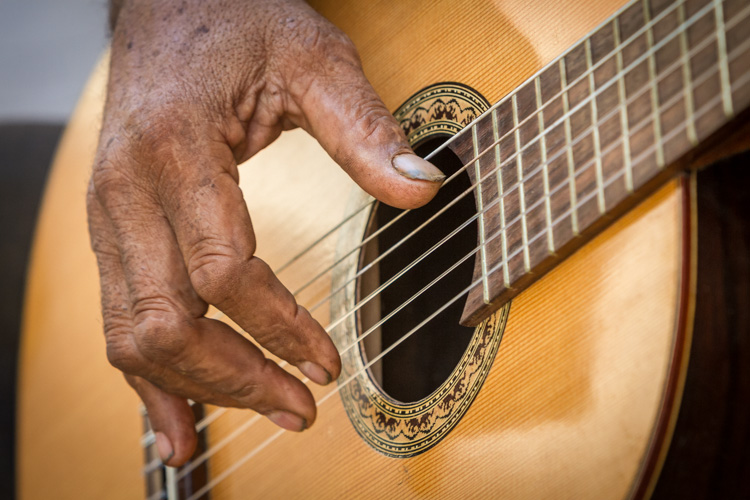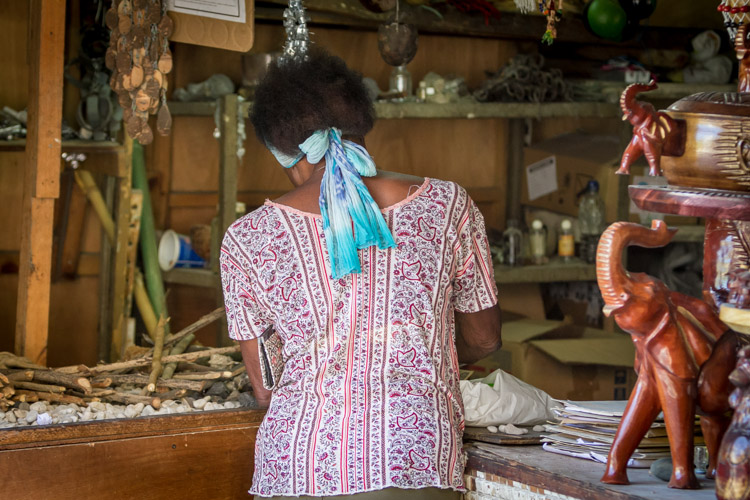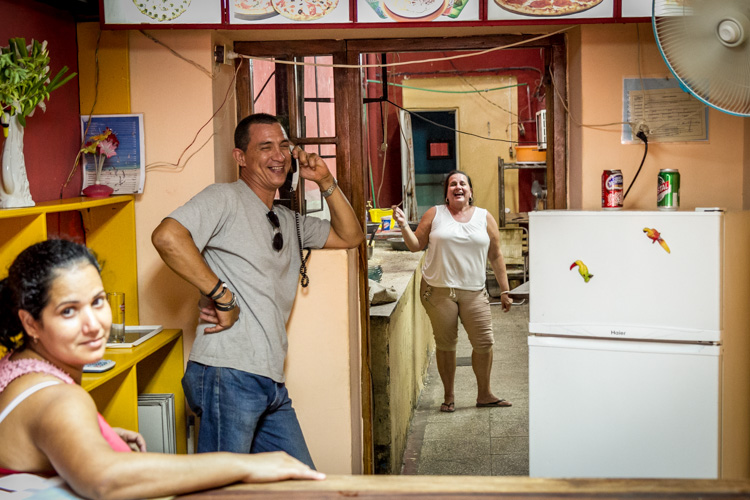Charismatic Public Life of Havana
It outweighs the hype of consumer individualism in US cities
Photo Feature by HT reader Branson Quenzer
HAVANA TIMES — There is nothing new about knowing that the rhythms of Cuba’s music are distinct and fantastic. They are played nightly for tourists, but what many visitors to Cuba miss are the local sounds of the neighborhoods, and it is on the streets where the real pulse of Havana can be found. Music is free to the ‘barrios’ of Havana’s many enthusiastic residents, and song and dance spill into the streets engaging the neighborhood in a chorus of evening activity.
The days of public music in the US are virtually gone. Speakers have been replaced by earphones, windows and doors are closed and locked because people are apprehensive about strangers, and local noise regulations have stopped all spontaneous events. The result is an introverted individual who carries on his/her day alone, possibly with music, but without knowing how or ever seeing it being created.
On the hotter days when Havana’s air is barely mustering a breeze residents often reduce themselves to letting the stereo blast out tunes from the balconies with open shutters as they relax begging for any bit of Caribbean wind to refresh the air. The Cuban vibes reverberate between the buildings, and the young neighborhood boys with more resistance to the summer swelter gather shooting marbles or playing baseball as if in a popular music video.
The US has become tone deaf and has turned public culture on mute. US cities are full of people who work to death and close off the world around them by using portable media devices either to tune out or to plug into a 2 cent mind-numbing video game.
A more visual vibrant orchestra of colors with a bit more of a chaotic beat are the markets of Havana. Fruits are still weighed by hand, and prices change and fluctuate requiring shoppers to interact with the product and its seller. There is a sense of vitality in the marketplace where fruits and vegetables are stacked, sorted and displayed… 1 peso espresso bars take root on the periphery of the market giving patrons and sellers alike a caffeine buzz to keep the market hopping even in the summer heat.
‘Super’ markets have replaced local markets all over the United States. Now, there are even super super markets that sell house appliances next to, outdoor grass fertilizers, next to your fruits and vegetables. These massive overstocked warehouses have millions of brand names of consumer goods that really no one needs, but for some reason most people are compelled to buy. Anyone who is working there is doing so silently stacking items and scanning barcodes in a store uniform which is exactly the same as the next guy.
But in Havana, slushy carts are pushed along the markets as they leak melting ice under the shade of an umbrella providing even more color and refreshments to the market. And if you are in the mood for a snack, churros, peanuts or popcorn can all be purchased in conical formed paper envelops that keep food not only on the mind but in the bellies of Havana residents. Not to mention the smiles, jokes and stories that boisterous sellers joyfully tell keeping the whole market alive and stocked with not only produce but laughter as well. Sure they are at work, but since when did work mean that living life needed to end. Rather, in the Havana markets it is a place to begin trading goods and the intricacies of Cuban culture.
In a culture that boasts ideological individuality as the US does, the individual is certainly lost in the walls of commercial branding. Shoppers smile awkwardly at each other as they pass by pushing their oversized shopping trollies. An aura of uncomfortable silence permeates the store which corporate owners try to nullify by playing top 50 hits. It doesn’t work as the Americans spend themselves into debt.
Most laymen have become aware of over the last decades that hyperbolic rhetoric is more entertainment than political reality. It is increasingly becoming less endorsed and hopefully less tolerated. And what comes of more strait talk in the ever increasingly small world we live in is the realization that common people are more similar than different. Let’s hope that the US doesn’t export more of its consumer culture and begins to learn from Havana’s charismatic streets.
—–
Visit: www.bransonQ360.com
Click on the thumbnails below to view all the photos in this gallery. On your PC or laptop, you can use the directional arrows on the keyboard to move within the gallery. On cell phones use the keys on the screen.























Number 2 fruit is mango of which there are 26 varieties in Cuba. If there was agricultural competence in Cuba, the country could have a thriving export industry – but with an aging General as Minister of Agriculture pursuing socialist concepts, production only goes down, down, DOWN!
Quite a few years ago, the Government of Mexico funded a Mexican business to purchase the marketing rights of a well-known banana label for $5 billion. Thus they managed to move production of that brand from Equador to Mexico. The fact is that 99% of bananas marketed are of one variety.
I suppose that if there were no bananas for a day fewer folks would slip on the skins.
In that case, I would direct you to my response to Grady’s comment.
Product life cycles sure tell interesting stories… thanks for sharing your expertise. I just wonder, would the world end if we didn’t have bananas for a day. I know someone’s stock price would go down, but shortages have been part of the natural world for billions of years. Insatiability is the issue of wants… what are our needs?
I second
Grady R. Daugherty’s
comments three years ago in an article “Trying to Destroy the Cuban Revolution”
As one who did consultancy in the food industry, I found the photographs very familiar – including the ripening units which if similar to ones which I have designed, can control the number of days from receipt at stage 2 (very green) to stage 5/6 when they are ready for retail.
One of the interesting facets is food safety and Europe leads North America with every aspect of the chain being recorded from field to distribution centres to stores. In consequence if there is a problem with a particular product – for example food poisoning from strawberries, the individual field of production can be traced within 24 hours. In North America such identity is not recorded.
But in recognising that Europe is leading, it is interesting to note that consumers are now increasingly seeking ‘locally’ produced food with small specialized stores now rapidly increasing in number. The supermarkets in response are now giving the source of many of the fresh products. The worm is turning and consumers will actually willingly pay more for ‘local’ products which they perceive as being both fresher and of higher quality.
As you indicate, within the industry they are very coy about permitting photography.
There is a big difference between the warehouses you showed and food processing plants. The latter are complex and especially in Europe under very strict regulation necessitating very detailed design. Processing is defined as changing the nature or form of a product providing a regulatory difference between an onion and a peeled onion.
My reason for saying this is that the supermarkets in Europe were the first to realise the advantages of publicising food safety and were 20 years ahead of Canadian supermarkets.
It is a trick question to enquire where one can find the largest quantity of bananas in the world. Folks will respond with Equador or Mexico etc. The actual answer is Rotterdam which is the European centre for distribution – within 24 hours by road and rail there is a population of over 380 million (more than the US and Canada combined).
Finally, nidal shehadeh mentions the price of an avocado in the US being up to $2 (in Canada about $1.40 for a tiny Mexican one. In Cuba one can buy the best avocados I have experienced for 5 pesos each and up to 9″ in size. But what has to be remembered is that 5 pesos is a quarter to a fifth of a days pay for a Cuban. $2 is 10 minutes or less work for a working North American.
You’ve captured the essence of what I love about Cuba while, at the same time, reflecting acute insights about what our own homeland has become. Although the America of fifty or sixty years ago was no Paradise Lost (e.g. the racism, segregation, homophobia of that time, plus most women being confined to rigid sexual and social roles), on the other hand, over this past half-century there have been great losses, too: then there were more folks making, and sharing, through direct and personal experience, their own music; now most folks passively listen to pop artists pushed by the corporate music biz., or at best, relay their homogenized, main-stream preferences; small family businesses, such as restaurants, clothing and hardware stores, local hotels and motel, for example, are all now replaced, or are dalily being replaced, by soulless corporate franchises. A good essay, integrated with perceptive fotos which illustrate and reinforce your thesis.
Wealth can be measured in many ways… the strangest thing is it is usually measured by what you don’t have (the green grass on the other side of the fence) rather than knowing the comparative advantages of what you do have.
Carlyle, thanks for your thoughts. I almost included a farmers market reference, but space was limited… in fashionable ways the US is definitely trying to reintroduce the community that was so prevalent 50 years ago.
Some of the logistics behind the scenes of those always ripe bananas can be found here: http://bransonq360.com/p133464059
I used to live in Vancouver Canada I agree with you on the availability , but at what price when I was in Peru I noticed fruits and vegetables used to feed livestock have a higher quality then some of the tropical foods they sell in Canada , avocado can cost up to $2 a piece .
Over here in the US and Canada we buy a single papaya , in Peru we used to buy a box of whatever food I liked , and what a selection of fantastic foods and vegetables , delicious fruits and vegetables , here in South Florida I have my own oranges , papayas , bananas , grapes, mulberry tree to feed the whole neighborhood ,eat your heart out Sacramento .
Cubans would find much more individual cultural activities in European countries than in the US and as more European tourists visit Cuba than Americans, that is perhaps where the comparison should have been made. The shops and restaurants of the European countries are not all franchised as by far the majority of those in the US are.
On the other hand, US supermarkets offer a far greater selection of fruits and vegetables than is available in Cuba where the fruits are only available seasonally and so few vegetables are available. My wife rejoices in Canada at the range of available high quality vegetables and fruits – many of which are of US origin. In Canada the number and scale of so-called “farmers markets” is constantly increasing as is the trade they attract.
May I suggest that it would be helpful to widen the horizons beyond the US. The rest of the world awaits.
Hahahahaha! This writer is such a tourist! His kitschy descriptions reek of a guy in town for a couple weeks. Those agros he so lovingly romanticized are dark, dirty and pest-ridden. And what he calls “expresso bars” are most often somebody’s grandma selling the chickpea-filled coffee through the living room window facing the street. Obviously Branson has not spent any time in East Los Angeles or the South Side of Chicago or north of 125th Street in Harlem or even the Mission District here in San Francisco. If he had he would have had his ears filled with street music and spontaneous culture. Likewise, he has little awareness of Small Town, USA. People still say hello when they pass each other on the street and they know their neighbors. Branson, if you are reading this please be aware that my in-laws in Cuba can spend ALL afternoon going between those little stores you try to glamorize just to find food for dinner or shampoo or detergent. The constant shortages of one thing or another make everyday life a lot harder for Cubans just to have the basics like cooking oil, eggs, toilet paper and potatoes. Because of my wife, my in-laws have the $$$ to buy what they want. It is much worse for those trying to live on the slave wages that the Castros pay Cubans. Why would you wish to deny my in-laws the convenience of the Walmart superstore? My mother-in-law could go to one place and get everything that she needs. She could spend more time at home with her family instead of walking the broken and dirty streets in a hot sun looking for toilet paper. I bet $’s to donuts you don’t have to hunt down eggs to eat. Don’t be so naive Branson.
It sure doesn’t reek of prosperity!!